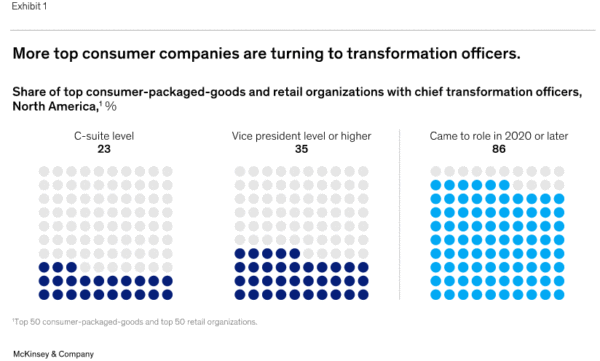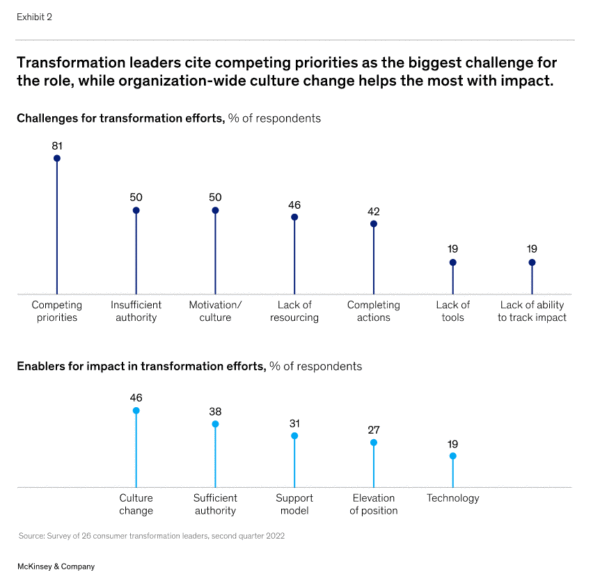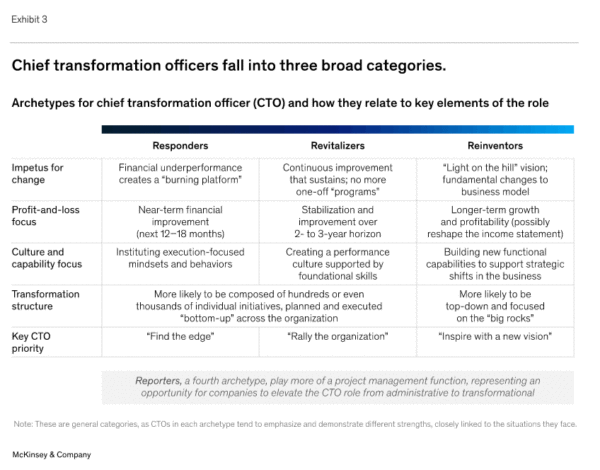Meet the newest member of the consumer C-suite: The chief transformation officer
December 8, 2022

Consumer preferences continue to change, straining already tight margins and stranding companies that have not shifted effectively to digital and omnichannel. Supply chain problems and geopolitical turbulence are spurring regionalization, testing even the nimblest company’s ability to respond quickly. Meanwhile, persistent inflation and rising interest rates are increasing the cost of capital, forcing companies to restructure their balance sheets. Fears of a global downturn are growing; a recent survey of CEOs found that 81 percent expect a recession.
To address these challenges effectively, CPG and retail companies must reconsider their approach to transformation. It’s not just a fancy word for cost reduction. Instead, these companies should approach transformation holistically and with an eye toward the long term so that they don’t have to come up with “yet another change program” every two years. They need to build new capabilities that are not just functional but rather foundational—involving the whole organization rather than creating more directives from the top.
This is where the chief transformation officer (CTO) comes in. A growing number of CPG and retail company CEOs are turning to a CTO as a vital member of the executive team to lead a holistic transformation rather than relying exclusively on existing structures and roles. Given this new trend, we wanted to find out how consumer companies can empower the CTO to meet the challenges of a transformation from day one.
We reached out to nearly 40 current and former CTOs and other transformation leaders across leading CPG and retail companies. 1 We asked them about the scope of their jobs, the common pitfalls they faced, the mindsets and personal factors that helped them adapt and succeed, and the organizational support they received or felt was missing. Their insights may be helpful to other consumer organizations as they onboard a transformation chief or redefine the role for existing CTOs. Getting the details right will be critical—in fact, a successful transformation may depend on it.
The CTO role: The current state of play
Our research found that of one hundred prominent CPG and retail companies—the top 50 in North America in each category—23 percent employ enterprise-level CTOs, defined as executive-suite transformation officers reporting directly to the CEO. When expanded to include transformation leaders at the level of vice president or higher (those who may have enterprise or functional transformation responsibilities), that number rises to 35 percent. Of the CPG and retail companies with established CTO positions, 86 percent say their current CTOs came to their roles in 2020 or later, indicating that many companies are newly embracing this function (Exhibit 1).

There are more CTOs in CPG and retail companies of various sizes today, but the scope of the role itself remains inconsistently defined. Some of this is understandable, since the context, scope, and objectives of a transformation vary. For example, some CTOs told us they were tasked with specific and relatively targeted financial mandates (for instance, to reduce supply chain costs by 200 basis points). Others were given broader goals tied more closely to corporate strategy—for instance, to help the company achieve 10 to 12 percent growth over the next three years, or to shift the business toward a direct-to-consumer model. Finally, others were asked to achieve culture- and capability-oriented goals, such as breaking down silos between functions or increasing digital adoption across the company. Some, in fact, were asked to take on many of these challenges simultaneously.
At the same time, many of the transformation leaders we spoke with recognize that the role of the CTO is also uniquely challenging. CTOs often “own nothing but are accountable for everything.” They must balance providing accountability with offering sufficient support and delivering on ambitious targets. They often have a small team of their own but are mobilizing and training hundreds of people. They might be perceived as a glorified cost cutter or project manager if not empowered appropriately. Additionally, because the role has not existed as long as others in the C-suite, there isn’t a clear road map of what it takes to do the job successfully.
And indeed, our survey of transformation leaders themselves revealed some of these common challenges. At the top of their list was the problem of competing priorities within the company, followed by a lack of authority to make changes and a lack of motivation within teams. They saw boosting organizational involvement in the transformation and elevating their authority as crucial ways to have more impact (Exhibit 2).

CTO archetypes: The three ‘Rs’
It’s not surprising that the CTO role isn’t a one-size-fits-all position. In fact, the general demands of a CTO can be broken down into three categories, based on the conditions leading to the transformation and level of change required within it (Exhibit 3).

- Responder. As the name suggests, these CTOs are put in place primarily to respond to a crisis or major setback; examples from our interviews included heightened macroeconomic pressures, existential competitive threats, or shifts in consumer preferences. Responders must triage and stabilize the business and almost always need to enable rapid and substantial financial improvements. Responders tend to focus their cultural changes on instilling new levels of discipline and speed, and build capabilities tied to execution rather than new technical skills. Although personal styles can vary, responder CTOs are more likely to suggest a need to bring more “edge” to bear to achieve results.
- Revitalizer. Revitalizers may well be expected to drive significant performance improvements, but that often comes with an added emphasis on sustained, long-term change. CTOs can find themselves in a revitalizer role when a business has seen its performance degrade slowly over time, or if it is coming off a series of cost-cutting events and wants to create a new and lasting culture of continuous improvement. These CTOs will place a heavy emphasis on mobilizing and empowering the organization, helping it build new foundational and leadership capabilities to sustain change over time. In the absence of a traditional burning platform (as the responders have), these CTOs often need to dig deep to find ways to rally and inspire employees for the new journey ahead.
- Reinventor. Whereas responders and revitalizers are typically driving change within the existing strategy of the company, reinventors are often asked to lead the company through substantial strategic changes—for example, by shifting a business model from brick and mortar to digital or entering an entirely new product category or market. Given the nature of change involved, reinventors often need to help employees build completely new and unfamiliar capabilities (and, potentially, new organizations or teams). For these CTOs, the ability to connect the dots across functions is especially important, as is the ability to articulate a clear strategic vision of the future state.
As described above, CTOs in each archetype tend to emphasize and demonstrate different strengths, closely linked to the situations they face. Equally, each archetype must be aware of potential risks specific to their situation. For example, responders—justifiably focused on near-term performance improvements—might have neither the capacity nor the luxury to think beyond the next six to 12 months and the detailed tactics that will help the company thrive in that turbulent period. Meanwhile reinventors, working in service of a grand strategic vision, may be less focused on near- or midterm financial performance.
It is worth noting that while the archetypes are clear and differentiated, the CTOs playing the roles might not be. That is to say, transformation journeys (and the environments in which they exist) evolve, and the CTOs at the helm could be asked to do the same. This might play out in a natural sequence, with a CTO going from responder to revitalizer to reinventor as the company recovers from financial challenges, sets a sustainable foundation, and then evolves strategically. But the journey can also be unpredictable: for example, one consumer products CTO started out as a revitalizer but had to pivot to a responder role as acute supply chain challenges emerged and threatened the business.
Finally, there are some transformation leaders who do not fit into any of these three archetypes. They are not responders, revitalizers, or reinventors but rather reporters. They tend to play more of a project management role and are effectively asked to collect and “report the news” on how these projects are progressing. But this remit, while helpful on the surface, can limit the potential of the CTO role. Companies and CEOs have an opportunity to elevate reporters from a role that’s administrative to one that’s truly transformational.
The CTO skill set: A recipe for success
Our research indicates that although the three CTO archetypes are different, there is a common set of personal characteristics critical to making the role a success. Typically, the ideal CTO is a business generalist who carries a big emotional tool kit, including the curiosity and humility to ask questions across the organization and the diplomatic range to build consensus and enthusiasm across a swath of business units outside the CTO’s direct control. The person in this role must have credibility across the organization.
The job requires walking a line between holding others accountable and providing adequate support. It’s a dual function that not everyone gets right, with some leaning too hard toward cracking the whip and others being too supportive at the expense of the broader mission. The successful CTO:
Has business acumen. All transformation leaders we interviewed, whether responders, revitalizers, or reinventors, noted the need to be a “connecter”—understanding implications of decisions across the business with a breadth of business experience. Many CTOs, particularly responders who must produce a financial change quickly, noted the need to understand the end-to-end value chain.
Thinks outside of silos. The effective CTO also has experience across multiple functions or domains. Those we surveyed told us that when initiatives were led out of a particular function, they would fall prey to the biases and preferences of that function, making true transformation more difficult. Senior leaders, including CTOs, who stay in a silo are much less likely to propel a successful transformation than those who take the time to address the gaps in their knowledge base.
The backgrounds of the CTOs we interviewed supported this point: across responders, revitalizers, and reinventors, leaders came from a variety of backgrounds, often with multiple experiences within a company (for example, technical finance or R&D, profit-and-loss owners, strategy). A minority of leaders wore two hats: transformation and strategy. This situation was most prevalent with reinventors who were changing a company’s underlying business model.
Can build trust and respect. In many ways, the CTO’s main leverage is through influence, so creating trust and respect are fundamental to being effective. Because they serve as the glue between other executives, CTOs need a potent blend of smarts and emotional intelligence to understand an issue and develop a path forward.
“You can’t come in and just disrupt the hornet’s nest without a reason,” one of our respondents noted. “I’ve worked with people who are bulldogs, and that wouldn’t have worked in our culture—[you] need to build trusting relationships with leaders to enable the right conversations at the right time.”
Is a curious and humble listener. Almost all the transformation leaders we spoke with noted their ability to act as a learner who empowers others. Part of that is understanding the big picture but also showing a desire to dive deep into the details. “There were times I had to change my mind because I was wrong, and it was OK,” one transformation leader told us. “You have to be willing to listen to someone who is five layers below you explain it to you, because you don’t know.”
“You need to be able to put yourself in the operator’s shoes,” said one consumer products transformation officer. “The moment you act as a knower, you will fail. You need to be an orchestrator and a challenger.” Another said she asked questions with a humble approach: “I don’t know this as well as you, but I know enough to know this doesn’t make sense yet.”
Is confident challenging the status quo. Transformation leaders unanimously noted the need to be comfortable with questioning all levels of the organization. Part of this is having the tenacity and stamina to see things to fruition, by sweating the details and holding peers accountable.
Respondents also stressed the importance of being able to challenge top leadership. “[My CEO] expects me to be open and direct—to tell him what he needs to know even if he doesn’t want to hear it,” the transformation chief of one retailer told us. “You’re DOA [dead on arrival] if you don’t have that.”
Brings out the best in others. Many CTOs noted that their own enthusiasm and personal commitment to change are useful in setting a broader tone. Some said the role was also an accelerator for careers, by giving others new responsibilities and challenging them to do more than they currently do or thought possible. “My superpower is helping people build confidence in themselves,” one transformation officer said.
McKinsey research shows that the overwhelming majority of transformations fail, with much of that failure stemming from leadership or employee resistance to change. A CTO’s ability to galvanize and inspire others is crucial to mobilizing the organization.
Keeps the organization’s energy up. Great CTOs realize that transformations are a marathon, not a sprint. Our research shows that 78 percent of transformation failure occurs after the initial stage, and 55 percent occurs during the long journey of implementation. Leaders who beat the odds are able to keep up the organization’s energy, focus, and commitment to transformation over time. The CTOs we spoke with found creative ways of doing this that fit with their culture. “In one month, we had milestone completion contests; in another month, we solicited crazy ideas to improve the business,” one transformation officer said.
The organization: Five factors that position a CTO for success
In our experience with hundreds of transformations worldwide, we’ve found that the most successful CTOs benefit from strong and sustained organizational support so they can drive true transformation. This support most frequently manifests itself in five ways.
Unwavering support from the CEO
CTOs are most successful when they are positioned as a peer to the top team and C-suite, operating with the full backing of the CEO in words and deeds. These CTOs often point to a CEO who is willing to engage and make the tough calls (including turning others away if they try to make an end run around the CTO). As one CTO put it, “I am a confidant to the CEO.”
License to engage all employees
Our research has shown that transformations are far more likely to succeed when a significant percentage of employees meaningfully participate in driving the change (for instance, by owning an initiative). CTOs must have the mandate to mobilize the broader organization. A CTO’s direct team can be small, but its organizational footprint should be large. “We have over 350 people involved,” a CTO told us. “Not everyone is an initiative owner, but everyone has objectives related to initiatives.”
A well-oiled ‘execution engine’
The transformation office—and the new operating speed that goes with it—is central to the CTO’s ability to deliver real and lasting change. As one CTO noted, “We are going into year three and I still maintain a weekly cadence, which is critical to maintaining the success and momentum of our transformation.”
A robust incentive program
Our research shows that companies that implemented financial incentives tied directly to transformation outcomes achieved almost a fivefold increase in total shareholder returns. One CTO referred to himself as “the chief bonus officer.” However, the most successful transformations typically deploy a mix of financial and nonfinancial incentives, all the while keeping in mind the variety of factors that motivate employees.
Emphasis on the ‘soft stuff’ (to drive hard results)
Several CTOs we interviewed emphasized the importance of changing mindsets and behaviors, which is critical to creating sustained performance improvement and to helping employees build new capabilities. In some cases, CTOs said they used the transformation office as a “leadership academy” to train the next generation of high performers at the company.
The CTO role is unique by design, requiring a versatile leader with the conviction and flexibility to adapt to whatever circumstances arise. The CTOs we spoke with said they truly enjoyed the job, while noting the high-risk, high-reward nature of it. “The work is incredibly exciting and impactful,” one leader told us. “It is also very time intensive and emotionally taxing.” In this era of nonstop disruption, consumer companies that recognize the value of the CTO role are positioning their transformations to succeed as well.
About the author(s)
AD Bhatia is a partner in McKinsey’s New Jersey office; Kevin Carmody is a senior partner in the Chicago office, where Kristi Weaver is a senior partner; Rebecca Johnson is a consultant in the Bay Area office; Emily Rizzi is a consultant in the Pittsburgh office; and Jim Scott is a partner in the Washington, DC, office.
The authors wish to thank Kevin Blasko and Amy Daschle for their contributions to this article.






























